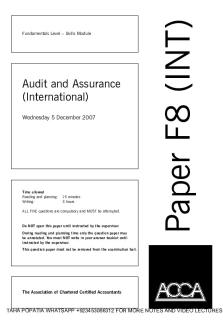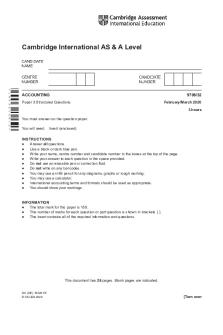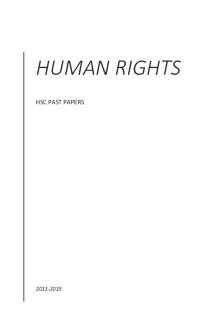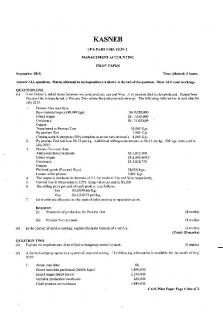ACCA F8 (AA) Past Papers 10 years PDF

| Title | ACCA F8 (AA) Past Papers 10 years |
|---|---|
| Course | F8 - Audit and Assurance |
| Institution | Association of Chartered Certified Accountants |
| Pages | 122 |
| File Size | 1.8 MB |
| File Type | |
| Total Downloads | 861 |
| Total Views | 1,002 |
Summary
Fundamentals Level – Skills ModuleTime allowed Reading and planning: 15 minutes Writing: 3 hoursALL FIVE questions are compulsory and MUST be attempted.Do NOT open this paper until instructed by the supervisor.During reading and planning time only the question paper may be annotated. You must NOT wr...
Description
Audit and Assurance (International) Wednesday 5 December 2007
Time allowed Reading and planning: Writing:
15 minutes 3 hours
ALL FIVE questions are compulsory and MUST be attempted.
Do NOT open this paper until instructed by the supervisor. During reading and planning time only the question paper may be annotated. You must NOT write in your answer booklet until instructed by the supervisor.
Paper F8 (INT)
Fundamentals Level – Skills Module
This question paper must not be removed from the examination hall.
The Association of Chartered Certified Accountants
TAHA POPATIA WHATSAPP +923453086312 FOR MORE NOTES AND VIDEO LECTURES
7D–INTPA Paper F8INT 7D–INTAA Paper F8INT
ALL FIVE questions are compulsory and MUST be attempted 1
DinZee Co assembles fridges, microwaves, washing machines and other similar domestic appliances from parts procured from a large number of suppliers. As part of the interim audit work two weeks prior to the company year-end, you are testing the procurement and purchases systems and attending the inventory count. Procurement and purchases system Parts inventory is monitored by the stores manager. When the quantity of a particular part falls below re-order level, an e-mail is sent to the procurement department detailing the part required and the quantity to order. A copy of the e-mail is filed on the store manager’s computer. Staff in the procurement department check the e-mail, allocate the order to an authorised supplier and send the order to that supplier using Electronic Data Interchange (EDI). A copy of the EDI order is filed in the order database by the computer system. The order is identified by a unique order number. When goods are received at DinZee, the stores clerk confirms that the inventory agrees to the delivery note and checks the order database to ensure that the inventory were in fact ordered by DinZee. (Delivery is refused where goods do not have a delivery note.) The order in the order database is updated to confirm receipt of goods, and the perpetual inventory system updated to show the receipt of inventory. The physical goods are added to the parts store and the paper delivery note is stamped with the order number and is filed in the goods inwards department. The supplier sends a purchase invoice to DinZee using EDI; invoices are automatically routed to the accounts department. On receipt of the invoice, the accounts clerk checks the order database, matches the invoice details with the database and updates the database to confirm receipt of invoice. The invoice is added to the purchases database, where the purchase day book (PDB) and suppliers individual account in the payables ledger are automatically updated. Required: (a) List SIX audit procedures that an auditor would normally carry out on the purchases system at DinZee Co, explaining the reason for each procedure. (12 marks) (b) List FOUR audit procedures that an auditor will normally perform prior to attending the client’s premises on the day of the inventory count. (2 marks) (c) On the day of the inventory count, you attended depot nine at DinZee. You observed the following activities: 1. 2. 3.
4. 5. 6.
Prenumbered count sheets were being issued to client’s staff carrying out the count. The count sheets showed the inventory ledger balances for checking against physical inventory. All count staff were drawn from the inventory warehouse and were counting in teams of two. Three counting teams were allocated to each area of the stores to count, although the teams were allowed to decide which pair of staff counted which inventory within each area. Staff were warned that they had to remember which inventory had been counted. Information was recorded on the count sheets in pencil so amendments could be made easily as required. Any inventory not located on the pre-numbered inventory sheets was recorded on separate inventory sheets – which were numbered by staff as they were used. At the end of the count, all count sheets were collected and the numeric sequence of the sheets checked; the sheets were not signed.
Required: (i)
List the weaknesses in the control system for counting inventory at depot nine.
(3 marks)
(ii) For each weakness, explain why it is a weakness and state how that weakness can be overcome. (9 marks)
2
TAHA POPATIA WHATSAPP +923453086312 FOR MORE NOTES AND VIDEO LECTURES
7D–INTAA Paper F8INT
(d) (i)
State the aim of a test of control and the aim of a substantive procedure.
(ii) In respect of your attendance at DinZee Co’s inventory count, state one test of control and one substantive procedure that you should perform. (4 marks)
7D–INTAB Paper F8INT
(30 marks)
2
(a) Explain each of the FIVE fundamental principles of ACCA’s Code of Ethics and Conduct.
(5 marks)
(b) ISA 570 Going Concern provides guidance to auditors in respect of ensuring that an entity can continue as a going concern. Required: Explain the actions that an auditor should carry out to try and ascertain whether an entity is a going concern. (5 marks)
7D–INTAC Paper F8INT
(10 marks)
3
Matalas Co sells cars, car parts and petrol from 25 different locations in one country. Each branch has up to 20 staff working there, although most of the accounting systems are designed and implemented from the company’s head office. All accounting systems, apart from petty cash, are computerised, with the internal audit department frequently advising and implementing controls within those systems. Matalas has an internal audit department of six staff, all of whom have been employed at Matalas for a minimum of five years and some for as long as 15 years. In the past, the chief internal auditor appoints staff within the internal audit department, although the chief executive officer (CEO) is responsible for appointing the chief internal auditor. The chief internal auditor reports directly to the finance director. The finance director also assists the chief internal auditor in deciding on the scope of work of the internal audit department. You are an audit manager in the internal audit department of Matalas. You are currently auditing the petty cash systems at the different branches. Your initial systems notes on petty cash contain the following information: 1. 2. 3. 4. 5. 6.
7.
The average petty cash balance at each branch is $5,000. Average monthly expenditure is $1,538, with amounts ranging from $1 to $500. Petty cash is kept in a lockable box on a bookcase in the accounts office. Vouchers for expenditure are signed by the person incurring that expenditure to confirm they have received re-imbursement from petty cash. Vouchers are recorded in the petty cash book by the accounts clerk; each voucher records the date, reason for the expenditure, amount of expenditure and person incurring that expenditure. Petty cash is counted every month by the accounts clerk, who is in charge of the cash. The petty cash balance is then reimbursed using the ‘imprest’ system and the journal entry produced to record expenditure in the general ledger. The cheque to reimburse petty cash is signed by the accountant at the branch at the same time as the journal entry to the general ledger is reviewed.
Required: (a) Explain the issues which limit the independence of the internal audit department in Matalas Co. Recommend a way of overcoming each issue. (8 marks) (b) Explain the internal control weaknesses in the petty cash system at Matalas Co. For each weakness, recommend a control to overcome that weakness. (12 marks) (20 marks)
3
[P.T.O.
TAHA POPATIA WHATSAPP +923453086312 FOR MORE NOTES AND VIDEO LECTURES
7D–INTAD Paper F8INT
4
Delphic Co is a wholesaler of furniture (such as chairs, tables and cupboards). Delphic buys the furniture from six major manufacturers and sells them to over 600 different customers ranging from large retail chain stores to smaller owner-controlled businesses. The receivables balance therefore includes customers owing up to $125,000 to smaller balances of about $5,000, all with many different due dates for payments and credit limits. All information is stored on Delphic’s computer systems although previous audits have tended to adopt an ‘audit around the computer’ approach. You are the audit senior in charge of the audit of the receivables balance. For the first time at this client, you have decided to use audit software to assist with the audit of the receivables balance. Computer staff at Delphic are happy to help the auditor, although they cannot confirm completeness of systems documentation, and warn that the systems have very old operating systems in place, limiting file compatibility with more modern programs. The change in audit approach has been taken mainly to fully understand Delphic’s computer systems prior to new internet modules being added next year. To limit the possibility of damage to Delphic’s computer files, copy files will be provided by Delphic’s computer staff for the auditor to use with their own audit software. Required: (a) Explain the audit procedures that should be carried out using audit software on the receivables balance at Delphic Co. For each procedure, explain the reason for that procedure. (9 marks) (b) Explain the potential problems of using audit software at Delphic Co. For each problem, explain how it can be resolved. (8 marks) (c) Explain the concept of ‘auditing around the computer’ and discuss why this increases audit risk for the auditor. (3 marks) (20 marks)
4
TAHA POPATIA WHATSAPP +923453086312 FOR MORE NOTES AND VIDEO LECTURES
7D–INTAE Paper F8INT
5
(a) You are the audit manager in JonArc & Co. One of your new clients this year is Galartha Co, a company having net assets of $15 million. The audit work has been completed, but there is one outstanding matter you are currently investigating; the directors have decided not to provide depreciation on buildings in the financial statements, although International Accounting Standards suggest that depreciation should be provided. Required: State the additional audit procedures and actions you should now take in respect of the above matter. (6 marks) (b) Unfortunately, you have been unable to resolve the matter regarding depreciation of buildings; the directors insist on not providing depreciation. You have therefore drafted the following extracts for your proposed audit report. 1.
‘We conducted our audit in accordance with International Standards on Auditing. Those Standards require that we comply with ethical requirements and plan and perform the audit to obtain reasonable assurance about whether the financial statements are free of material misstatement (remaining words are the same as a normal unmodified report).
2.
As discussed in Note 15 to the financial statements, no depreciation has been provided in the financial statements which practice, in our opinion, is not in accordance with International Accounting Standards.
3.
The charge for the year ended 30 September 2007, should be $420,000 based on the straight-line method of depreciation using an annual rate of 5% for the buildings.
4.
Accordingly, the non-current assets should be reduced by accumulated depreciation of $1,200,000 and the profit for the year and accumulated reserve should be decreased by $420,000 and $1,200,000, respectively.
5.
In our opinion, except for the effect on the financial statements of the matter referred to in the preceding paragraph, the financial statements give a true and fair view ... (remaining words are the same as for an unmodified opinion paragraph).’
The extracts have been numbered to help you refer to them in your answer. Required: Explain the meaning and purpose of each of the above extracts in your draft audit report.
(10 marks)
(c) State the effect on your audit report of the following alternative situations: (i)
Depreciation had not been provided on any non-current asset for a number of years, the effect of which if corrected would be to turn an accumulated profit into a significant accumulated loss.
(ii) JonArc & Co were appointed auditors after the end of the financial year of Galartha Co. Consequently, the auditors could not attend the year end inventory count. Inventory is material to the financial statements. Note: you are not required to draft any audit reports. (4 marks) (20 marks)
End of Question Paper
5
TAHA POPATIA WHATSAPP +923453086312 FOR MORE NOTES AND VIDEO LECTURES
Audit and Assurance (International) Wednesday 4 June 2008
Time allowed Reading and planning: Writing:
15 minutes 3 hours
ALL FIVE questions are compulsory and MUST be attempted.
Do NOT open this paper until instructed by the supervisor. During reading and planning time only the question paper may be annotated. You must NOT write in your answer booklet until instructed by the supervisor.
Paper F8 (INT)
Fundamentals Level – Skills Module
This question paper must not be removed from the examination hall.
The Association of Chartered Certified Accountants
TAHA POPATIA WHATSAPP +923453086312 FOR MORE NOTES AND VIDEO LECTURES
ALL FIVE questions are compulsory and MUST be attempted 1
Introduction – audit firm You are an audit senior in Brennon & Co, a firm providing audit and assurance services. At the request of an audit partner, you are preparing the audit programme for the income and receivables systems of Seeley Co. Audit documentation is available from the previous year’s audit, including internal control questionnaires and audit programmes for the despatch and sales system. The audit approach last year did not involve the use of computerassisted audit techniques (CAATs); the same approach will be taken this year. As far as you are aware, Seeley’s system of internal control has not changed in the last year. Client background – sales system Seeley Co is a wholesaler of electrical goods such as kettles, televisions, MP3 players, etc. The company maintains one large warehouse in a major city. The customers of Seeley are always owners of small retail shops, where electrical goods are sold to members of the public. Seeley only sells to authorised customers; following appropriate credit checks, each customer is given a Seeley identification card to confirm their status. The card must be used to obtain goods from the warehouse. Despatch and sales system The despatch and sales system operates as follows: 1.
Customers visit Seeley’s warehouse and load the goods they require into their vans after showing their Seeley identification card to the despatch staff.
2.
A pre-numbered goods despatch note (GDN) is produced and signed by the customer and a member of Seeley’s despatch staff confirming goods taken.
3.
One copy of the GDN is sent to the accounts department, the second copy is retained in the despatch department.
4.
Accounts staff enter goods despatch information onto the computerised sales system. The GDN is signed.
5.
The computer system produces the sales invoice, with reference to the inventory master file for product details and prices, maintains the sales day book and also the receivables ledger. The receivables control account is balanced by the computer.
6.
Invoices are printed out and sent to each customer in the post with paper copies maintained in the accounts department. Invoices are compared to GDNs by accounts staff and signed.
7.
Paper copies of the receivables ledger control account and list of aged receivables are also available.
8.
Error reports are produced showing breaks in the GDN sequence.
Information on receivables The chief accountant has informed you that receivables days have increased from 45 to 60 days over the last year. The aged receivables report produced by the computer is shown below: Number of receivables 15 197 153 23 –––– 388 ––––
Range of debt
Total debt $
Less than $0 $0 to $20,000 $20,001 to 50,000 $50,001 or more
(87,253) 2,167,762 5,508,077 1,495,498 –––––––––– 9,084,084 ––––––––––
Current $ (87,253) 548,894 2,044,253 750,235 –––––––––– 3,256,129 ––––––––––
1 to 2 months old $
More than 2 months old $
643,523 2,735,073 672,750 –––––––––– 4,051,346 ––––––––––
975,345 728,751 72,513 –––––––––– 1,776,609 ––––––––––
In view of the deteriorating receivables situation, a direct confirmation of receivables will be performed this year.
2
TAHA POPATIA WHATSAPP +923453086312 FOR MORE NOTES AND VIDEO LECTURES
Required: (a) Explain the steps necessary to check the accuracy of the previous year’s internal control questionnaires. (4 marks) (b) Using information from the scenario, list SIX tests of control that an auditor would normally carry out on the despatch and sales system at Seeley Co and explain the reason for each test. (12 marks) (c) State and explain the meaning of FOUR assertions that relate to the direct confirmation of receivables. (4 marks) (d) (i)
Describe the procedures up to despatch of letters to individual receivables in relation to a direct confirmation of receivables. (5 marks)
(ii) Discuss which particular categories of receivables might be chosen for the sample.
(5 marks) (30 marks)
2
(a) List and explain FOUR factors that will influence the auditor’s judgement regarding the sufficiency of the evidence obtained. (4 marks) (b) ISA 580 Management Representations provides guidance on the use of management representations as audit evidence. Required: List SIX items that could be included in a management representation letter.
(3 marks)
(c) After performing tests of controls, the auditor is of the opinion that audit evidence is not sufficient to support the audit opinion; in other words many control errors were found. Required: Explain THREE actions that the auditor may now take in response to this problem.
(3 marks) (10 marks)
3
[P.T.O.
TAHA POPATIA WHATSAPP +923453086312 FOR MORE NOTES AND VIDEO LECTURES
3
(a) With reference to ISA 520 Analytical Procedures explain (i)
what is meant by the term ‘analytical procedures’;
(2 marks)
(ii) the different types of analytical procedures available to the auditor; and
(3 marks)
(iii) the situations in the audit when analytical procedures can be used.
(3 marks)
Zak Co sells garden sheds and furniture from 15 retail outlets. Sales are made to individuals, with income being in the form of cash and debit cards. All items purchased are delivered to the customer using Zak’s own delivery vans; most sheds are too big for individuals to transport in their own motor vehicles. The directors of Zak indicate that the company has had a difficult year, but are pleased to present some acceptable results to the members. The income statements for the last two financial years are shown below: Income statement
Revenue Cost of sales Gross profit Operating expenses Administration Selling and distribution Interest payable Investment income Profit/(loss) before tax
31 March 2008 $000 7,482 (3,520) –––––– 3,962
31 March 2007 $000 6,364 (4,253) –––––– 2,111
(1,2...
Similar Free PDFs

ACCA F8 (AA) Past Papers 10 years
- 122 Pages

ACCA F8 Past exam
- 91 Pages

ACCA F8 Audit past paper
- 5 Pages

acca sbr past papers practice
- 49 Pages

9706 past papers
- 28 Pages

Past exams papers 2
- 10 Pages

Past Papers Human Rights
- 14 Pages

AC100 - Past exam papers
- 15 Pages

Management Accounting Past Papers
- 38 Pages

CRIMINAL LAW PAST PAPERS
- 4 Pages

Topical past papers
- 27 Pages

Accounting 100 past papers
- 2 Pages

ACCA F8 Class Notes skans accounting
- 213 Pages

Skans- Ecampus- AA F8 -BOOK 2019
- 205 Pages
Popular Institutions
- Tinajero National High School - Annex
- Politeknik Caltex Riau
- Yokohama City University
- SGT University
- University of Al-Qadisiyah
- Divine Word College of Vigan
- Techniek College Rotterdam
- Universidade de Santiago
- Universiti Teknologi MARA Cawangan Johor Kampus Pasir Gudang
- Poltekkes Kemenkes Yogyakarta
- Baguio City National High School
- Colegio san marcos
- preparatoria uno
- Centro de Bachillerato Tecnológico Industrial y de Servicios No. 107
- Dalian Maritime University
- Quang Trung Secondary School
- Colegio Tecnológico en Informática
- Corporación Regional de Educación Superior
- Grupo CEDVA
- Dar Al Uloom University
- Centro de Estudios Preuniversitarios de la Universidad Nacional de Ingeniería
- 上智大学
- Aakash International School, Nuna Majara
- San Felipe Neri Catholic School
- Kang Chiao International School - New Taipei City
- Misamis Occidental National High School
- Institución Educativa Escuela Normal Juan Ladrilleros
- Kolehiyo ng Pantukan
- Batanes State College
- Instituto Continental
- Sekolah Menengah Kejuruan Kesehatan Kaltara (Tarakan)
- Colegio de La Inmaculada Concepcion - Cebu

